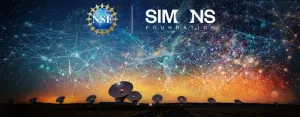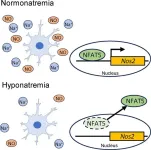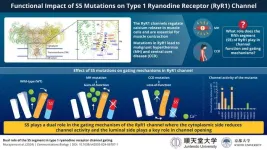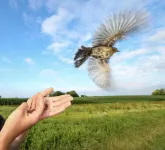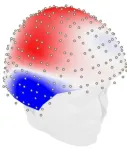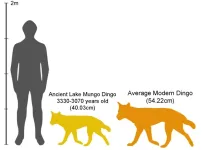(Press-News.org) Note: Embargoed until 8:00 a.m. ET on Sept. 18, 2024
From the early telescopes made hundreds of years ago by Galileo to the sophisticated astronomical observatories of today, people have built increasingly innovative tools to probe and measure the cosmos. Soon, researchers at two new institutes funded by the U.S. National Science Foundation and the Simons Foundation will build a new breed of astronomical tools by harnessing the uniquely powerful abilities of artificial intelligence to assist and accelerate humanity's understanding of the universe.
The new National Artificial Intelligence Research Institutes for astronomical sciences are part of the NSF-led National Artificial Intelligence Research Institutes program, which now includes 27 AI institutes across the U.S. The two new institutes will each receive $20 million over five years: $10 million from NSF and $10 million from the Simons Foundation.
"The massive amount of data that will be gathered in the coming years by the NSF-DOE Vera C. Rubin Observatory and other large-scale astronomical projects is simply too vast and rich to be fully explored with existing methods," says NSF Director Sethuraman Panchanathan. "With reliable and trustworthy AI in their toolbox, everyone from students to senior researchers will have exciting new ways to gain valuable insights leading to amazing discoveries that might otherwise remain hidden in the data."
"Astronomy has incredibly rich and open data sets and is poised for more deep and profound inquiry," says Simons Foundation President David Spergel. "AI offers novel tools that can use this data both to produce transformative results and to develop tools that can have impact in other fields."
Both institutes aim to advance the capabilities of AI beyond just astronomical sciences so it can become a more useful tool for all scientific disciplines involving large datasets, sophisticated models and the iterative process of generating and experimentally testing theories.
The new AI Institutes for astronomical sciences are:
NSF-Simons AI Institute for Cosmic Origins (NSF-Simons CosmicAI)
Led by The University of Texas at Austin in collaboration with NSF NOIRLab, the NSF National Radio Astronomy Observatory, the University of Utah, the University of Virginia and UCLA, NSF-Simons CosmicAI aims to accelerate traditionally time-consuming aspects of astronomical research, such as processing and analyzing large amounts of data and creating and evaluating simulations of complex phenomena like the chemical processes within stars. The institute plans to democratize access to astronomical data and analysis by developing a powerful AI-based assistant that provides accurate responses to scientific queries.
NSF-Simons AI Institute for the Sky (NSF-Simons SkAI)
Led by Northwestern University in collaboration with The University of Chicago, the University of Illinois Urbana-Champaign, the University of Illinois Chicago, and the Adler Planetarium, NSF-Simons SkAI will tackle exceptionally complex problems in astrophysics and astronomy across a broad range of cosmic scales, from the physics of exotic objects like neutron stars and black holes to the formation of galaxies and the role that dark matter and dark energy play across the entire universe.
The institutes will seek to empower researchers at all career levels by providing access to trustworthy AI that can rapidly conceptualize and assist in research projects with full access to all published astronomical data and findings.
Training and education for early-career researchers and students is another objective the institutes will pursue over the next five years. The institutes will conduct a variety of outreach activities to broadly disseminate their innovations and help train the AI-literate workforce of tomorrow. Those activities include summer schools for high school students and teachers and the development of online courses allowing scientists and students anywhere in the U.S. to gain certification in the burgeoning field of AI-assisted astronomy.
Launched in 2020, the NSF-led AI Institutes are part of a broad federal effort to advance a cohesive approach to AI-related opportunities and risks and support the goals outlined in the White House's 2023 "Executive Order on the Safe, Secure, and Trustworthy Development and Use of Artificial Intelligence." For more information about NSF's decades-long support for foundational AI research and the AI Institutes program, visit NSF's Artificial Intelligence webpage.
About the U.S. National Science Foundation
The U.S. National Science Foundation propels the nation forward by advancing fundamental research in all fields of science and engineering. NSF supports research and people by providing facilities, instruments and funding to support their ingenuity and sustain the U.S. as a global leader in research and innovation. With a fiscal year 2024 budget of $9.06 billion, NSF funds reach all 50 states through grants to nearly 2,000 colleges, universities and institutions. Each year, NSF receives more than 40,000 competitive proposals and makes about 11,000 new awards. Those awards include support for cooperative research with industry, Arctic and Antarctic research and operations, and U.S. participation in international scientific efforts.
Get News Updates by Email
Useful NSF Web Sites:
NSF Home Page: https://www.nsf.gov
NSF News: https://www.nsf.gov/news/
Science and Engineering Statistics: https://www.nsf.gov/statistics/
Awards Searches: https://www.nsf.gov/awardsearch/
###
END
Low serum sodium concentrations in blood are called hyponatremia, a prevalent clinical electrolyte disorder. In contrast to acute hyponatremia, chronic hyponatremia has been previously considered asymptomatic because the brain can successfully adapt to hyponatremia. If not treated, chronic hyponatremia can lead to complications such as fractures, falls, memory impairment, and other mental issues. Treating the chronic condition is, however, quite tricky as it has been observed that overly rapid correction of hyponatremia ...
EMBARGOED by Alzheimer’s & Dementia until 7 a.m., ET, Sept. 18, 2024
Contact: Gina DiGravio, Boston University, 617-358-7838, ginad@bu.edu
Contact: Andrea Zeek, IU School of Medicine, 317-671-3114, anzeek@iu.edu
(Boston)— The failure to diagnose Alzheimer’s disease, the most common form of dementia in the elderly, at an early stage of molecular pathology is considered a major reason why treatments fail in clinical trials. Previous research to molecularly diagnose Alzheimer’s disease yielded "A/T/N" central biomarkers based on the measurements of proteins, β-amyloid (“A”) and tau (“T”), ...
About The Study: In this study, a higher burden of comorbidity was associated with worse clinical outcomes in people with multiple sclerosis (MS), although comorbidity could potentially be a partial mediator of other negative prognostic factors. The findings suggest a substantial adverse association of the comorbidities investigated with MS disease activity and that prevention and management of comorbidities should be a pressing concern in clinical practice.
Corresponding Author: To contact the corresponding author, Amber Salter, PhD, email amber.salter@utsouthwestern.edu.
To access the embargoed study: Visit our For The Media website at this ...
London, United Kingdom, 18 September 2024 – UK Research and Innovation (UKRI), the UK’s largest public funder of research, has confirmed funding for a new phase of the DARE UK (Data and Analytics Research Environments UK) programme with up to £18.2 million made available over 2.5 years.
Starting this month, Phase 2 of the DARE UK programme will bring together Trusted Research Environments (TREs) across the UK to test and build new capabilities for a connected national network of secure data ...
The type 1 ryanodine receptor (RyR1) is an important calcium release channel in skeletal muscles essential for muscle contraction. It mediates calcium release from the sarcoplasmic reticulum, a calcium-storing organelle in muscle cells, a process vital for muscle function. Mutations in the RyR1 gene can affect the channel's function in extremely contrasting ways leading to severe muscle diseases such as malignant hyperthermia (MH) and central core disease (CCD). MH is an inherited disease that causes high fever and muscle contractures in response to inhalational anesthetics in patients with gain-of-function RyR1 variants. CCD is one ...
Millions of birds migrate every year to escape winter, but spending time in a warmer climate does not save them energy, according to research by the Max Planck Institute of Animal Behavior (MPI-AB). Using miniaturized loggers implanted in wild blackbirds, scientists recorded detailed measurements of heart rate and body temperature from birds every 30 minutes from fall to the following spring—the first time the physiology of free flying birds has been quantified continuously at this scale over the entire wintering period. The data offer unprecedented insights into the true energetic costs of migrant and resident strategies and reveal a previously unknown mechanism used by migrants to ...
Amyloid-beta and tau proteins have long been associated with Alzheimer’s disease. The pathological buildup of these proteins leads to cognitive decline in people with the disease. How it does that, though, remains poorly understood.
A new study from the labs of Sylvain Baillet at The Neuro and Sylvia Villeneuve at the Douglas Research Centre provides important insight into how these proteins impact brain activity and possibly contribute to cognitive decline.
The team led by Jonathan Gallego Rudolf, a Ph.D. candidate in Baillet and Villeneuve’s ...
UPTON, N.Y. — Scientists from the U.S. Department of Energy’s (DOE) Brookhaven National Laboratory have shown that a type of qubit whose architecture is more amenable to mass production can perform comparably to qubits currently dominating the field. With a series of mathematical analyses, the scientists have provided a roadmap for simpler qubit fabrication that enables robust and reliable manufacturing of these quantum computer building blocks.
This research was conducted as part of the Co-design Center for ...
New archaeological research by the University of Sydney has discovered for the first time clear links between fossils of the iconic Australian dingo, and dogs from East Asia and New Guinea.
The remarkable findings suggest that the dingo came from East Asia via Melanesia, and challenges previous claims that it derived from pariah dogs of India or Thailand.
Previous studies used traditional morphometric analysis – which looks at the size and shape of the animal using callipers – ...
The National Multiple Sclerosis Society (USA) has awarded a grant of 1 million dollars to Dr. Isabel Pérez-Otaño, who leads the Plasticity and Remodeling of Neural Circuits laboratory at the Institute for Neurosciences (IN), a joint center of the Spanish National Research Council (CSIC) and the Miguel Hernández University (UMH) of Elche. The grant is part of the NMSS 'Pathways to Cure' program that funds innovative therapeutic approaches to treat multiple sclerosis (MS). The team will work on identifying mechanisms that mediate a special kind of brain plasticity, known as myelin plasticity. The goal is to find ways to stimulate myelin plasticity ...
